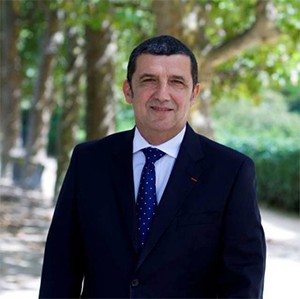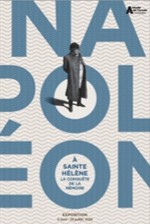How did this exhibition come about?
Thierry Lentz: We must pay tribute here to the directors of the Musée de l'Armée for having so enthusiastically welcomed the idea of a major exhibition about Napoleon on Saint Helena, when the president of the Fondation, Victor-André Masséna*, suggested it to them about two or three years ago. At that time, we knew that thirty original items of furniture from Longwood were to be transported to France for restoration. We really wanted the contributors to the “Save Napoleon's House on St Helena” appeal to be able to see them, since it was thanks to their donations that this exceptional operation was made possible. The Army museum officials – whose director, currently Division General Christian Baptiste, is, let us not forget, the statutory “guardian of the tomb of the Emperor” – said “You're on!” and then expanded the concept so that a “wider public” could also come and see, and spend time and learn something in the course of the exhibition. Accordingly, the Foundation felt it would be desirable to provide significant sponsorship to the project and to participate in the preparation of the exhibition as indeed the Musée de l'Armée desired. Everything has gone as planned, and now the time has come to present to the public not only the most important furniture from Longwood, but also dozens of historic souvenirs from St Helena.
For the Fondation Napoléon, this exhibition is the culmination of several years of work with the French Ministry of Foreign Affairs and the French Domains of St Helena. Can you tell us a little about this collaboration?
 Thierry Lentz: As part of our mission for the preservation of the Napoleonic heritage and as a result of discussions with the Ministry of Foreign Affairs, we decided to undertake the major restoration of the Generals' Wing at Longwood. The Ministry was able to contribute 700,000 euros and the Fondation Napoléon, with the help of the Souvenir Napoléonien, organised an international appeal in order to raise additional funds: Thanks to 1,600 donors, we were able to increase this sum by 1.5 million euros. We were therefore able to consecrate the additional funds to more extensive restorations including the room where the Emperor died, his bathroom, the old stables and the roof of the commons areas. All the work, supervised by head architect of the Monuments Historiques (historical monuments), was carried out by a local contractor, in compliance with the original deadline, estimate and specifications. As part of this restoration project, as the French Domains of St Helena still possess almost all of the original furniture from the period of exile, which had not been restored for 200 years, we decided to bring to France the 32 most important pieces, leaving the 78 others which will be looked after on St Helena by a professional who has received specialist trained thanks to a grant from the Government of St Helena. The furniture transferred to France has been restored under the supervision of curators in French workshops. The most emblematic of these pieces will be presented in the exhibition at the Army Museum, before being taken back to Longwood. The exhibition will therefore be a unique opportunity to see them in Paris.
Thierry Lentz: As part of our mission for the preservation of the Napoleonic heritage and as a result of discussions with the Ministry of Foreign Affairs, we decided to undertake the major restoration of the Generals' Wing at Longwood. The Ministry was able to contribute 700,000 euros and the Fondation Napoléon, with the help of the Souvenir Napoléonien, organised an international appeal in order to raise additional funds: Thanks to 1,600 donors, we were able to increase this sum by 1.5 million euros. We were therefore able to consecrate the additional funds to more extensive restorations including the room where the Emperor died, his bathroom, the old stables and the roof of the commons areas. All the work, supervised by head architect of the Monuments Historiques (historical monuments), was carried out by a local contractor, in compliance with the original deadline, estimate and specifications. As part of this restoration project, as the French Domains of St Helena still possess almost all of the original furniture from the period of exile, which had not been restored for 200 years, we decided to bring to France the 32 most important pieces, leaving the 78 others which will be looked after on St Helena by a professional who has received specialist trained thanks to a grant from the Government of St Helena. The furniture transferred to France has been restored under the supervision of curators in French workshops. The most emblematic of these pieces will be presented in the exhibition at the Army Museum, before being taken back to Longwood. The exhibition will therefore be a unique opportunity to see them in Paris.
For us this is the culmination of a process that has taken many years. That said, our work will not really be complete until the restored furniture is back in place at Longwood House, probably at the beginning of next year.
Besides the furniture from Longwood, what else will we be able to see in the exhibition?
Thierry Lentz: One of the interesting aspects of this exhibition is that it will be a chance to see objects and works that simply have not been seen in public for ages. The idea is to present them via an appealing scenography and in an intelligent informative way which we hope will engage the public – even those not yet as knowledgeable on the subject as us Napoleonists!
The principal objects from St Helena have not been displayed to the public for years. The Musée National du Château de Bois-Préau [managed by the Château de Malmaison] where the bulk of the memorabilia of St Helena are kept, in particular those from the Marchand collection, has been closed since 1999 and, to my knowledge, there is no plan to reopen it in the near future. Apparently, that is not a priority. All the souvenirs of St Helena are carefully preserved in storage boxes into which they will most likely return for a long time after this exhibition. The other principal caretaker of the historical memorabilia from St Helena is the Musée de l'Armée (Army Museum in Paris) which, since the restructuring of that museum in the early part of this century, no longer has them on permanent display. Let us not forget that the Army museum also possesses the very bed in which the Emperor breathed his last, so this moving object, in more ways than one, will of course be part of the exhibition.
To sum up then, besides loans from other institutions and the furniture from Longwood, this is a unique opportunity to see all these ghosts of history released from their storage exceptionally and gathered together in one place. The most important objects will be there, with a few exceptions – the Château de Malmaison refused to lend certain objects such as the shirt Napoleon was wearing on 5 May 1821 at 5.49 in the evening and the manuscript of Marchand's Memoirs. Why? Conservation reasons, apparently. It is a great shame because there will not be another opportunity to bring all these pieces together again anytime soon.
The exhibition will be a rare chance to wander amongst an ensemble of objects that will never be seen again in Paris – I am talking about the Longwood furniture here -, not forgetting of course the other ‘French' pieces that will disappear back into storage. What better excuse could there be for hurrying along to the Army Museum in Paris?
February 2016
* Victor Andre Massena, Prince of Essling, is also vice chairman of the Board of Trustees of the Musée de l'Armée, Paris.


